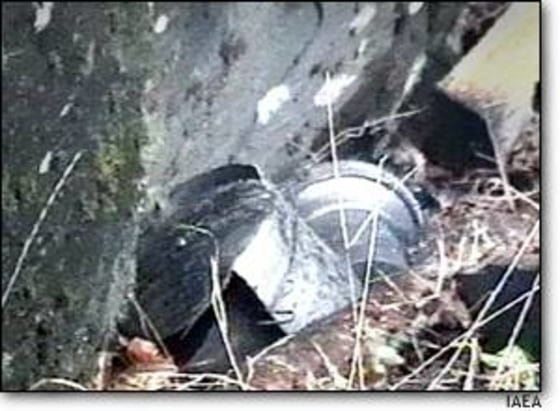A radioactive “dirty bomb” would be less devastating than a nuclear device but easier to create. Such a bomb would use conventional explosives to spread radioactive material over a small area — and spread panic far more widely, experts say. Even the reports of a dirty-bomb plot set off alarms Monday. And in an eerie coincidence, atomic watchdogs were searching for two radiation-powered generators from the Soviet era, devices that could provide raw material for a dirty bomb.
The radioactive material inside a dirty bomb could be as deadly as the strontium-90 stored within the discarded generators, which are thought to lie within a remote 200-square-mile area of the former Soviet republic of Georgia. It could even involve spent fuel rods containing uranium or plutonium, somehow stolen from a nuclear plant.
But it would more likely take the form of radioactive cobalt-60 or cesium-137 — found in the low-level waste from medical or research labs, or welding shops and construction sites.
Last month, the Nuclear Regulatory Commission disclosed that it received an average of 300 reports a year of small amounts of radioactive materials missing from such sources.
“There are hundreds of thousands of these, and not all of them are accounted for,” said John Pike, a weapons expert at GlobalSecurity.org.
Commission officials say they have no evidence of anyone collecting this material to have enough for a dirty bomb. But critics argue that no one is sure of that.
The fear factor
Creating a dirty bomb, also known as a radiological bomb, would involve grinding the radioactive material into dust, then placing it within a device also containing conventional explosives — for example, dynamite stolen from a construction site. When the bomb is set off, the radioisotope could be dispersed as dust or vapor.
In an alternative scenario, the radioisotope would be burned covertly, slowly spreading the emissions. The “burning candle” might go undetected until people became ill.
Depending on the strength of a dirty-bomb blast and the potency of the radioactive material, an area the size of a subway station or several city blocks could be contaminated.
The most visible damage would be done by the conventional explosives. In a letter responding to a recent inquiry from Rep. Ed Markey, D-Mass, Nuclear Regulatory Commission Chairman Richard Meserve downplayed the potential health impact from the radiation.
“A few closest to the explosion might inhale enough radioactive material to obtain internal radiation doses exceeding the (100-millirem) NRC annual limit for members of the public, but they would not be expected to experience any prompt or latent health effects as a result,” Meserve said.
In contrast, a crude nuclear bomb, in which there is a nuclear chain reaction, could kill tens of thousands of people over a 3-mile radius of the blast. Thousands more would suffer radiation poisoning from such an attack.
Still, the simple use of radioactive material with conventional explosives could hamper rescue work, create a cleanup problem and cause fear and public panic, experts say.
“I think that the fears would be absolutely enormous, dealing a devastating blow to the economy. ... Clearly, this would have superseded even the 9/11 attacks,” Steven Emerson, an expert on counterterrorism, said on MSNBC cable.
In March, the Center for Strategic and International Studies led officials from the Washington area through a scenario that involved the detonation of a cesium-137 “dirty bomb” just outside the National Air and Space Museum.
“The presence of radioactivity was an issue that the participants were clearly not prepared to deal with. ... This would seem to indicate that the greater Washington region could be unprepared for unconventional terrorist attacks involving materials that have the potential of contaminating large areas,” the center reported afterward. (Click to read the report in Adobe Acrobat format.)
International dimension
The search currently under way in western Georgia, spearheaded by the Vienna-based International Atomic Energy Agency, highlights the international dimension of the radiation threat. IAEA spokeswoman Melissa Fleming said that the concern over terrorism has added to the urgency of securing hazardous radiation sources that are currently unaccounted for.
The two missing nuclear-powered generators are among eight that were left behind by the Soviet military when they abandoned their bases in Georgia, in the wake of the Soviet Union’s collapse, Fleming said. She said six have been located and secured, including two that were found in a forest last December by Georgian lumberjacks. Two of the Georgians suffered severe radiation sickness and burns.
The current search — involving about 80 people on horseback, on foot and in motor vehicles — is expected to take two weeks, Fleming told MSNBC.com by phone from Vienna.
She said the IAEA believes several other former Soviet republics may face similar concerns about discarded Soviet-era radiation-powered thermal generators, but she declined to name the countries.
The strontium-90 generators are “extremely, extremely, extremely potent” and could be used in a radiological weapon, Fleming said, but the IAEA doesn’t consider them to be likely targets for terrorists. She said it would be technically difficult to convert the strontium salts into a dispersible form — assuming that terrorists found the generators in the first place.
“It’s been difficult for us to find them,” she said, “and we assume it would be equally if not more difficult for terrorists to come across them.”
NBC News producer Robert Windrem and The Associated Press contributed to this report.
